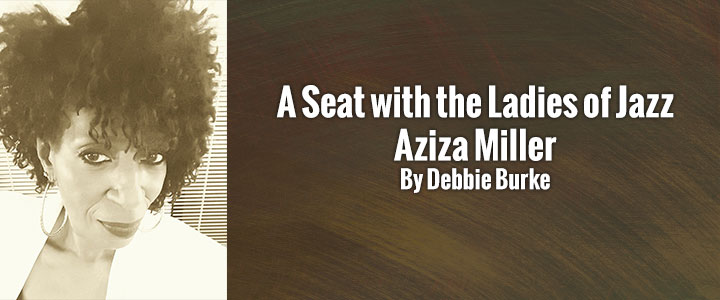Aziza Miller was a teacher in the New York City school system, and, because music has always been a huge part of her life, infused jazz into her classroom lessons whenever it was possible. She asked her students if they knew of any jazz musicians and found their realm of experience allowed for responses like Stevie Wonder or James Brown.
“I realize how blessed I was to be exposed not only to jazz but every kind of music,” recalls the pianist and singer. “The students didn’t get that exposure. I pondered over how I could pull them in so they would be interested.” She found her answer in rap, knowing the genre would pull them in and get them to listen.
“I wanted to give them a picture of the ladies of jazz,” she said. That was the inspiration for “J to the A.” The song highlights a wide range of jazz artists, male and female, and the songs they’re known for, including “A Night in Tunisia,” Coltrane’s “My Favorite Things” and “Naima,” and many more jazz chestnuts.
Aziza, like many others trying to break into the industry, kept her day job while performing in clubs at night when she could get gigs. One evening, she finished her set and a gentlemen in the audience by the name of Jimmy introduced himself. He was also a piano player. “He told me ‘I liked the way you play. Let me have your number because sometimes when I get gigs I can’t take, I’ll give them to you.’”
She didn’t expect to hear from him, but two weeks later he called. “He told me that there’s this new singer out who is Nat King Cole’s daughter and she’s looking for a piano player.” Jimmy said he was tired of traveling and didn’t want to do the gig, would she mind taking it?
Aziza took the offer and Natalie Cole hired her on the spot. Since then, Aziza’s career has taken off. She met Ahmed Jamal when she was working on Natalie’s song La Costa, and found out he loved the song so much that he recorded it himself instrumentally. “Then a couple of years later he wanted to know if I would consider writing lyrics to four of his compositions. My mind was totally blown away.”
Even though she retired from teaching in public schools in 1997, Aziza has continued teaching for organizations like the 92nd Street Y and the New York Foundation for the Arts, playing at church and giving private lessons.
How did you discuss jazz with the kids when you taught in the NYC school system?
I introduced jazz to my students during Black History and Women’s History Month. We would discuss, describe and define what jazz sounded like, where it began in America and who were some of the major contributors to this music. I wrote vocal jazz arrangements for my choirs of students to sing. They were so good at it that we caught the attention of Pope John Paul at the Vatican in Rome and multi Grammy award-winning composer Marvin Hamlisch who collaborated with me on a song he composed. He played piano and insisted that I conduct it at a concert with my students who sang at Madison Square Garden for the slain Israeli President Rabin.
How did you get started with music?
I had piano lessons at the age of 8, and I loved the instrument.
When did you start composing?
In 1977 I started composing music seriously. I was inspired by conversations, my travels and personal experiences.
Your sound is funk, jazz, smoothness and groove. A favorite subgenre?
I grew up on it all and I love those genres. I’m the summation of what I’ve digested.
Barriers and obstacles, if any, in the recording industry?
I really try not to let some people’s misconceptions of me define, undermine or confine me. I got my first big break in this music biz from the superstar Natalie Cole. She hired me in 1975 to be her first female music director/pianist and conductor. There weren’t many women doing that back then. I learned from her how to be powerful and confident in what I do.
My master’s degree in music education and a bachelor’s in theory has helped also. I can read, write, compose, transpose, sight sing and arrange music in many styles. My jazz teachers and mentors were pianist Kenny Barron and Horace Silver. The bassist and my friend Paul West gave me the tools I needed early on. I’m blessed.
Did you study the classical masters, and how did that inform your jazz sensibility?
Yes, Bach and Chopin. Classical music helps with technical facilitation and melodic awareness and appreciation.

One reply on “A Seat with the Ladies of Jazz”
It is so important that more women take their rightful place in music and society. 51% of human talent and intelligence is wasted otherwise.